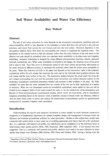Soil Water Availability and Water Use Efficiency
JIRCAS international symposium series
| ISSN | 13406108 |
|---|---|
| 書誌レコードID(総合目録DB) | AA1100908X |

本文フルテキスト
intlsymp-10_35-44.pdf352.17 KB
The rate of soil water extraction by roots depends on the momentary atmospheric conditions and soil water availability, which in turn depends on the resistance to water flow from the soil bulk to the soil-root interface, and water flow across the root tissues and into the root xylem. Moisture depletion in the rhizosphere induces water flow from the surrounding soil volume to replenish the depleted water. The hypothesis in the current lecture is that the dynamic rather than the static features of the soil water in the effective root zone should be considered when one examines water availability to the plant roots and irrigation scheduling. Irrigation scheduling is designed by using different soil parameters (porosity, density, saturated hydraulic conductivity, etc.). When water availability is included in the design, the retention curve of the given soil is used as well. Since this curve is intrinsically based on soil water statics and provides information on the water amount at different suctions, it represents the potential rather than the actual water availability to the plant. Water flux from the soil bulk to the plant root depends on the momentary value of the hydraulic conductivity within the soil volume that encircles the roots and on the hydraulic head gradient between this soil volume and the outer surface of the root. The momentary balance between the actual water flux from the soil volume surrounding the root and the potential water extraction rate (which depends mainly on the momentary atmospheric conditions) determines whether soil moisture is fully available to the plant. By "fully available" we mean that the water extracted from the vicinity of the root can be fully replenished in a matter of moments. When the root rhizosphere cannot be immediately replenished, water uptake by the root will be limited by the transport ability of soil water toward the roots, i.e. by the conductivity of the rhizospheric soil. Results of field, and greenhouse experimental studies, which verify the hypothesis, will be introduced. Irrigation scheduling based on the dynamic water availability concept increases water use efficiency, which is vital for areas where water is scarce, and reduces the deterioration of groundwater quality by agrochemicals transported by excessive irrigation water percolation.
| 作成者 | Rony Wallach |
|---|---|
| 公開者 | Japan International Research Center for Agricultural Sciences |
| オンライン掲載日 | |
| 号 | 10 |
| 開始ページ | 35 |
| 終了ページ | 44 |
| 言語 | eng |
